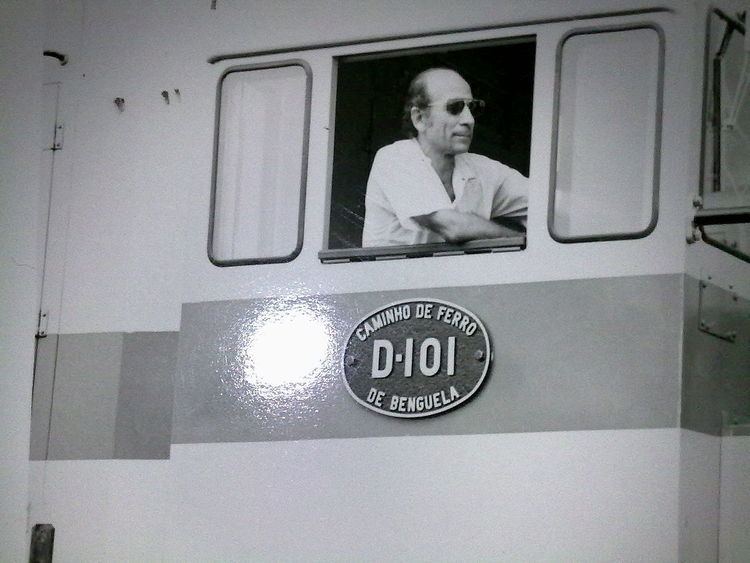Type Heavy rail Line length 1,344 km (835 mi) | Status Operational Termini LobitoLuau | |
 | ||
Opened 14 February 2015 (2015-02-14) | ||
The Benguela railway (Portuguese: Caminho de Ferro de Benguela (CFB)) is a Cape gauge railway in Angola that connects the Atlantic port of Lobito to the eastern border town of Luau. At the border, it connects to a branch of the Katanga Railway, providing access to the Copperbelts of Congo and Zambia. The railway is named after the city of Benguela, which is connected by a branch line to the terminus of Lobito.
Contents
Specifications
The railway is Cape gauge, 1,067 mm (3 ft 6 in), which is used by most mainline railways in southern Africa. The maximum design speed is 90 km per hour. The design capacity is 20 million tons of cargo and 4 million passengers per year. There are 67 stations and 42 bridges along the route of the railway.
The highest point on the railway is 6,082 feet.
History
The railway line roughly follows old trade routes between the ancient trading centre of Benguela and its hinterland of the Bié plateau. In 1899, the Portuguese government initiated the construction of the railway to give access to the central Angolan plateau and the mineral wealth of the then Congo Free State. A concession, running for 99 years, was granted to Sir Robert Williams on 28 November 1902. His Benguela Railway Company took over the construction which commenced on 1 March 1903. Messrs Pauling & Co. and Messrs Griffiths & Co were contracted to build sections of the railway. By 1914 when World War I started, 500 kilometres (310 mi) had been completed. Construction was halted until 1920 after which the railway's connection to Luau at the border to the Belgian Congo was completed in 1929. The primary purpose was the export trade and the "domestic Angolan traffic would be of secondary importance."
Passenger trains also ran between Lubumbashi and Lobito, connecting with passenger ship services to Europe. This provided a shorter route for Europeans working in the Katangan and Zambian Copperbelt, and the name "Benguela Railway" was sometimes used loosely to refer to the entire Lubumbashi–Lobito route, rather than the Luau–Lobito section to which it strictly applies.
In its heyday, the Benguela railway was the shortest way to transport mineral riches from the Congo to Europe. The line proved very successful and profitable, especially in the early 1970s after Zambia closed the border with the then Rhodesia. The railway reached an operational peak in 1973 when it transported 3.3 million tons of cargo, generated freight revenues of $30 million, and had 14,000 employees. Until the early 1970s, the railway was operated entirely by steam locomotives, oil-fired from the coast to Cubal, and then wood-fired from Cubal to the interior. Wood was supplied by eucalyptus trees grown on company-owned tree plantations. Steam locomotives outnumbered diesels as late as 1987.
Soon after Angola gained its independence from Portugal in 1975, the Angolan Civil War broke out. The railway was heavily damaged during the war and progressively fell into disuse. The workshops in Huambo were destroyed. Ballast cars had to be coupled to the front of locomotives to detonate mines. By 1992, only 340 km of the railway remained in operation. When the 99-year concession expired in 2001, only 34 km remained in service, along the coast from Benguela to Lobito.
Rehabilitation
The railway was 90% owned by Tanganyika Concessions Limited (Tanks), a London-based holding company. Société Générale de Belgique purchased a minority share in Tanks in 1923 and acquired a controlling interest in 1981. The Belgian company remained the controlling owner of the railway when the concession expired in 2001, at which point ownership of the railway passed to the Angolan government.
After the Angolan Civil War ended in 2002, the railway was reconstructed between 2006 and 2014 by the China Railway Construction Corporation at a cost of $1.83 billion. 100,000 Angolans were employed on the railway. Trains reached Huambo in 2011, Kuito in 2012, and Luau near the Congolese border in 2013. The rebuilt railway was formally inaugurated in February 2015.
According to Jornal de Angola in May 2012, CfB employs 1,321 workers, and transported 129,430 passengers and 5,640 tons of goods in 2011. Two trains per day run between Lobito and Benguela, one per week to Huambo, and three per week between Lobito and Cubal.
Accidents
In the Tolunda rail accident on 22 September 1994, damaged brakes caused a train to plunge into a canyon, killing 300.
